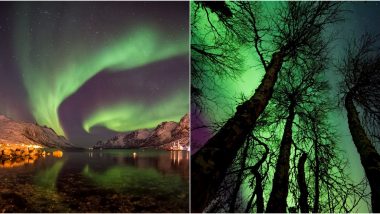The Northern Lights, also known as the Aurora Borealis have fascinated humans for centuries. The dazzling green lights in the night sky makes it a beautiful sight to watch. The recent one will be visible on Wednesday night and early Thursday morning across all of Canada. The Northern Lights are the result of collisions between gaseous particles from the Sun which enter the Earth's atmosphere. The colours are due to the charged particles from the Sun colliding with nitrogen and oxygen atoms in the earth's atmosphere. However, Northern Lights may lose its essence in the coming decade, partly due to climate change. Greenhouse gas emissions change the atmosphere's chemical composition resulting in the change. Northern Lights During Fall Equinox 2019: What Are Northern Lights? Where Is the Best Place to See Aurora? All Your FAQs Answered.
However, it won't make changes in oxygen and nitrogen which are 99 percent of our atmosphere, that account to the principal originators of the Northern Lights. There is an established correlation between the Northern Lights and sunspots on the surface of the Sun. The current solar cycle will also contribute to making the lights appear less frequently. The solar cycle takes 11 years during which the circulation and flow inside the sun change. The Sunspot activity follows an 11-year cycle, where the number fluctuates from just a few up to as high as 250 per annum. Hence, the Northern Light profusion is dependent on the Sun cycle. Amazed by Aurora Borealis Pics? Scientists Study How the Beautiful Phenomenon of Northern Lights Occur.
The least amount of solar activity or the fewest number of sunspots occur during solar minimum, which is expected in the coming time. According to NASA, sunspots are high in number during solar maximum as this part of the cycle is when the auroras are frequently spotted. Rodney Viereck, the head of research at the National Oceanic and Atmospheric Administration's Space Weather Prediction Center was quoted as saying, "We are on track to reach solar minimum sometime between 2019 and 2022. Then solar activity will slowly rise again." While there is an upcoming solar minimum, lights will still be visible. It will be less bright, less active, but can be seen in the sky. Viereck said, "The aurora never really goes away, it just becomes less active and it moves farther poleward."
(The above story first appeared on LatestLY on Nov 23, 2019 03:00 PM IST. For more news and updates on politics, world, sports, entertainment and lifestyle, log on to our website latestly.com).













 Quickly
Quickly












